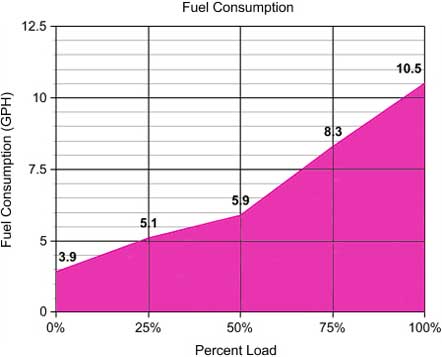
100% Off-grid Energy Setup and Phase-in Process for Eco-village Construction
Energy infrastructure and conservation methods are foundational to the creation of self-sufficient and self-propagating teacher/demonstration communities, villages, and cities to be built around the world. This page is an open source and free-shared guide to the setup and expansion of 100% off-grid energy infrastructure as part of the construction of teacher/demonstration hub food infrastructure, village models, the Duplicable City Center, and beyond.
This page contains the following sections related to 100% off-grid energy setup for eco-village construction:
- Related Pages
- What is 100% Off-grid Energy
- Why 100% Off-grid Energy
- Ways to Contribute
- Consultants
- 100% Off-grid Rollout Details
- Important Limitations to Understand before Getting Started
- Off-grid Energy Implementation Details for 10-20 People
- Off-grid Energy Implementation Details for 20-50 People
- Off-grid Energy Implementation Details for 50-100 People
- Off-grid Energy Implementation Details for 100-400 People
- Off-grid Energy Implementation Details for 400+ People
- Resources
- Summary
- FAQ
NOTE: THIS PAGE IS OUR RESEARCH AND DESIGN PROCESS TO THE POINT OF REALIZING
A GRID-TIED SYSTEM MAKES MORE SENSE FOR OUR PROJECT. YOU CAN READ ABOUT IT ON THE
HIGHEST GOOD ENERGY PAGE. IF YOU’D LIKE TO HELP FINISH THE DESIGNS ON THIS PAGE
FOR YOUR OWN PROJECT AND THE WORLD, CONTACT US USING OUR HELPING PAGE.
RELATED PAGES
WHAT IS 100% OFF-GRID ENERGY
 Completely off-grid energy is energy provided without any connection to a city grid. These systems are usually powered by solar, wind, or hydro power and using diesel generators as the emergency backup power systems. Diesel generators are usually used to provide power during the installation of the much larger and permanent power production systems and could also be used as a reliable long-term option for off-grid energy. The main reason not to run infrastructure exclusively on diesel generators is the environmental impact of diesel use (not eco-friendly) and because they only operate as long as enough fuel is supplied and stocked (not very secure or sustainable).
Completely off-grid energy is energy provided without any connection to a city grid. These systems are usually powered by solar, wind, or hydro power and using diesel generators as the emergency backup power systems. Diesel generators are usually used to provide power during the installation of the much larger and permanent power production systems and could also be used as a reliable long-term option for off-grid energy. The main reason not to run infrastructure exclusively on diesel generators is the environmental impact of diesel use (not eco-friendly) and because they only operate as long as enough fuel is supplied and stocked (not very secure or sustainable).
For a totally off-grid energy infrastructure using any system, the factors that need to be considered are:
- Peak and total demand at the selected site, by identifying electricity needs of various appliances
- Efficiency and cost of the equipment chosen
- Number of hours to operate per day
- If diesel generators: The type of fuel to be used, and quantity to be stored
For all these reasons, we recommend solar, wind, or hydro power as the foundations of your energy infrastructure coupled with an energy storage system and diesel generators as the backup system. The capacity of your storage will be site-specific, and a cost analysis should bring to light the practicality and extent of additionally installing such a system. The description below does not consider an energy storage system, and is solely based on the assumption of using a diesel generator system to power the needs of the initial survey team of 0-20, followed by the next wave of 20-50 additional residents/construction team members, and then being used as the emergency backup system.
WHY 100% OFF-GRID ENERGY
 The current global approach to energy is not sustainable and many people are seeking alternatives. One Community sees open source sharing the complete off-grid setup and expansion of energy infrastructure for beginning teacher/demonstration hubs through well-established hubs of 400+ people as a needed and desired stepping stone to global energy sustainability. Our goal is to promote conservation, all sustainable energy providers and technologies, and the viability of complete energy sustainability. We see making small-to-large group energy self-sufficiency easier, more affordable, and more attractive as part of our comprehensive approach to evolving sustainability that will positively and permanently transform the world for everyone.
The current global approach to energy is not sustainable and many people are seeking alternatives. One Community sees open source sharing the complete off-grid setup and expansion of energy infrastructure for beginning teacher/demonstration hubs through well-established hubs of 400+ people as a needed and desired stepping stone to global energy sustainability. Our goal is to promote conservation, all sustainable energy providers and technologies, and the viability of complete energy sustainability. We see making small-to-large group energy self-sufficiency easier, more affordable, and more attractive as part of our comprehensive approach to evolving sustainability that will positively and permanently transform the world for everyone.
With this in mind, the decision to go entirely off-grid could be based on multiple factors including:
- A desire for more earth-friendly energy
- A desire for autonomy or grid independence
- The high economic and logistical costs of paying for power from the grid
- The high economic and logistical costs of getting power from the grid to a remote location
Even for initial energy infrastructure setup, there are small-scale solar, wind, hydro, biogas, etc. options. However, due to the reliability, economics, and mobility advantages of diesel generators, they seem to be the cheapest and most feasible starting point, which is why we plan to use them for our initial rollout. After the rollout, they will provide emergency backup for the more sustainable and robust longterm solar, wind, and hydro power systems.
WAYS TO CONTRIBUTE TO EVOLVING THIS SUSTAINABILITY COMPONENT WITH US
SUGGESTIONS | CONSULTING | MEMBERSHIP | OTHER OPTIONS
CONSULTANTS ON OUR SUSTAINABLE ENERGY INFRASTRUCTURE
Doug Pratt: Solar Systems Design Engineer
Falgun Patel: Mechanical Engineer
Lorenzo Zjalarre: Physicist and Energy Efficiency Expert
Ramya Vudi: Electrical Engineer
Robert Seton: Solar Design Engineer and Owner of Solar Hybrid Design
Ron Payne: HVAC/Thermal Designer and Mechanical Engineer
Shubham Agrawal: Electrical Engineer
100% OFF-GRID ENERGY ROLLOUT DETAILS
Before One Community (or any off-grid teacher/demonstration community, village, or city) can begin being constructed in earnest, an initial team needs to move to the property to survey the land and begin food infrastructure preparation, finalize development plans, and create the “pre-infrastructure” that needs to exist to support the construction of everything that will follow. This group will need access to electrical power before much else can be done. From that point forward, more extensive and permanent infrastructure will be built.
What follows is the specific plan for this energy rollout research we did for a 100% off-grid development. It starts with the initial survey team of 0-20 people through our first 400. As part of our open source goals, this rollout is designed and described in detail to help those interested in duplication. We describe the process with the following sections:
- Important Limitations to Understand before Getting Started
- Off-grid Energy Implementation Details for 10-20 People
- Off-grid Energy Implementation Details for 20-50 People
- Off-grid Energy Implementation Details for 50-100 People
- Off-grid Energy Implementation Details for 100-400 People
- Off-grid Energy Implementation Details for 400+ People
Note: One Community’s design process evolved into a net-zero grid-tied system (still 100% sustainable), so it is different than what is on this page. You can read the details for why we made the decision to grid-tie on the Highest Good energy page. On that page you will also find our continuing and most current design details, details we stopped developing for the 100% off-grid intent once we realized a grid-tie would be better for our needs. With this in mind, sections in blue are areas we were seeking professional help to double check and we’d happily promote any group that wants to help finish the details of this page to match the quality and content on the Highest Good energy page – join our team if you’d like to help.
IMPORTANT LIMITATIONS TO UNDERSTAND
First and foremost when reading the details below (and as stated above), realize that we stopped developing these details when we made the decision to grid-tie. You can read about why we made this decision along with all the most current design details on the Highest Good energy page. In addition to this, there are some other important limitations you should be aware of.
First and foremost, prices below are current as of 9/2014. Second, it is not always possible to anticipate all possible energy demands accurately. We therefore, recommend adding in a factor of 1.2 while calculating peak capacity to ensure supply at all times. Earlier, since other sources of power were prohibitively expensive, the only available option for remote communities was diesel generators. However, in recent times, due to increased research, financing options, and improvements in manufacturing techniques, costs of solar and wind power have dropped dramatically. Also, the costs of transporting and storing the fuel are significant, which we did not factor in into our cost analysis below. Whenever you are reading this, the energy landscape has changed from what it was when we did our initial analysis and this means the selection of the appropriate energy source should change accordingly.
It is also important to consider the number of people you’ll be providing power to, and the lifetime of the energy source while making the decision. Diesel generators have lower initial costs, but very high operating costs, whereas solar and wind have high initial investments but almost no operating costs. Based on the life and payback period, the site’s energy source may be appropriately determined.
INITIAL SURVEY TEAM: ENERGY FOR 10-20 PEOPLE
 The primary focus of the solution for the initial people to move onto the property must be providing electricity as quickly as possible. There is also a need for flexibility of the generated power in order to provide the group with access wherever you need it. The design discussed here assumes this will be accomplished initially by diesel generators with a plan to purchase battery banks and begin construction of more permanent energy infrastructure the second month. Prices are accurate as of 9/2014.
The primary focus of the solution for the initial people to move onto the property must be providing electricity as quickly as possible. There is also a need for flexibility of the generated power in order to provide the group with access wherever you need it. The design discussed here assumes this will be accomplished initially by diesel generators with a plan to purchase battery banks and begin construction of more permanent energy infrastructure the second month. Prices are accurate as of 9/2014.
| Equipment Needed for this Phase | Cost | Details |
| 100 kW generator + add-on options | $22,124 | 100 kW generator (2400 kWh/day possible) – see efficiencies chart below |
| Towable Fuel Tank | $12,900 | 990 gallon towable fuel tank |
| Fuel cost for 1 month | $2,480 | Running at 16.8% for 5 hours/day (see below for details and efficiency graph) |
| Total | $37,504 |
Note: Eventually these generators should be mounted permanently on slabs if they become the permanent emergency backup system.
IMPLEMENTATION DETAILS FOR INITIAL SURVEY TEAM
In the beginning, the power needs will vary too much from day to day to start building longterm energy infrastructure. However, since the generators can be on trailers, they will easily provide access to the required electricity when and where it is needed:
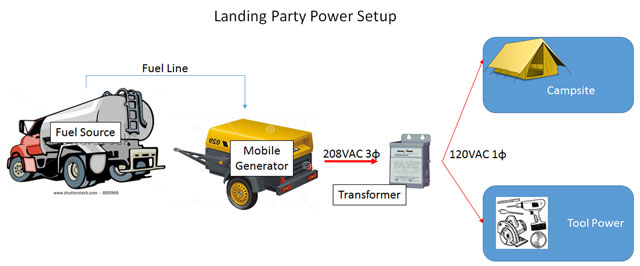
Landing Party Power Setup Overview
TASKS AFTER PURCHASING THE PROPERTY, BUT PRIOR TO “DAY 1”

Mobile Diesel Generat
- Select # of gen-sets and their capacity: Current estimates here were for the total capacity we originally calculated as necessary to cover the instantaneous power draw for the Earthbag Village and Duplicable City Center, which was â°Ë†400 kW. To provide the flexibility to supply power where it is needed, the total capacity was designed to be provided by multiple units (one 100 kW generator + two 175 kW generators = 450 kW total). At about a ton each, these would probably be best used on trailers for mobility. Later installations of generators would be permanently mounted on slabs.
The reasoning behind having a 100 kW gen-set first is that it will provide intermittent and mobile power for use on miscellaneous work sites throughout the property. The two 175 kW units would then be slab-mounted near the Duplicable City Center and the Earthbag Village (Pod 1), mostly to provide backup power for the Duplicable City Center which would service the most people and consume the majority of the power generated.
- Identify power needs for the “Landing party”: What absolutely NEEDS power and when is that power needed? (system sizing is dependent upon maximum simultaneous necessary usage). Possible items to consider are:
- Tool chargers
- Large equipment (cement mixers)
- Lights and heat for camp
- Size and obtain a fuel source: The fuel source should be sized to provide enough for the running of the generator at the team’s power needs for at least the amount of time the team is planning on this phase multiplied by a safety factor of 1.2.
- For the Landing Party of 20 people we assume that we will be using roughly 4.2 kWh/day per person (from Pod 1 per capita energy consumption). Over the course of the day we can assume that we run the generator for 5 hours continuously per day meaning that during that 5 hours the generator is running at 16.8 kW or 16.8%. Using the graph below we find that the 100 kW generator will consume 3.34 gallons per hour at that load. Multiplying the number of hours by the fuel consumption rate gives us 16.7 gallons/day times our safety factor of 1.2 gives us a final value of 20 gallons per day for the average day.
- Fuel storage on site would then be divided by 20 gallons per day to give us the number of days the fuel source can sustain the party. The 100 kW generator with the 250 gallon base tank would last the party roughly 12.5 days without filling. Fuel for an entire month would be 620 gallons total. At today’s prices that would come to roughly $2,480 per month for normal or $2,000 for farm diesel.
For easy fuel storage, a trailer would provide mobility for frequent refueling at a biodiesel fueling station or delivery service. For more permanent storage a bladder might be the best and most low-cost solution.
TASKS ON THE PROPERTY
- Purchase one gen-set and tow it to the property with pickup truck or similar.
- Transport fuel source to the property (see sizing information above).
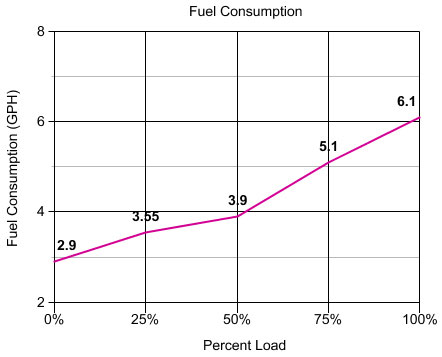
100 kW Generator Power Efficiency and Consumption Projections
Note: Fuel consumption per generated kW varies with electrical load when using a generator. The chart above shows average fuel consumption in relation to % output (load). Since this chart is for a 100 kW unit, the % load is equal to the kilowatt output (50% = 50 kW). You can use this data as a guide to size the fuel source.
THE FIRST WAVE: POWER FOR 20-50 PEOPLE
 After the “landing party” has completed their site survey, identified the locations of all planned construction (specific for buildings to be built in first 5 years, plus long-term general plan), begun working on the infrastructure, and completed and gained approval for all the initial building plans, the rest of the construction team would move onto the property. At this point, enough planning will have been done to begin working on the long-term energy infrastructure while still allowing for flexible power generation for construction needs. This means beginning to build the entire solar array to eventually service the Duplicable City Center and Earthbag Village (Pod 1).
After the “landing party” has completed their site survey, identified the locations of all planned construction (specific for buildings to be built in first 5 years, plus long-term general plan), begun working on the infrastructure, and completed and gained approval for all the initial building plans, the rest of the construction team would move onto the property. At this point, enough planning will have been done to begin working on the long-term energy infrastructure while still allowing for flexible power generation for construction needs. This means beginning to build the entire solar array to eventually service the Duplicable City Center and Earthbag Village (Pod 1).
| Equipment Needed for this Phase | Cost | Details |
| 175 kW generator + add-on options | $24,949 | 175 – 275 kW (4200 – 6600 kWh/day possible with one 100 kW generator and one 175 kW generator) |
| 1000 gallon Fuel Bladder | $2,406.69 | 1000 gallon fuel bladder |
| Fuel for 6 months 175 kW Gen or (100 kW generator) | $20,248.70 ($14,624.06*) | @28.6% for 4.2 hours per day (@50% for 4.2 hours / day*) |
| Energy Manager | $14,294.00 | SMA, Multicluster Box, 3-Ph for 12 x 120V, 60 Hz, SI5048U, add MC-PB, UL listed off-grid only, MCB-12U |
| Solar Array X3 (with batteries) | $1,419,926.88 | 283 kWh (849 kWh/December day) |
| Total | $1,419,926.88 |
* This is smaller for the same amount of energy production due to the increased efficiency of these generators when running at a higher percentage of its maximum.
20-50 PEOPLE POWER IMPLEMENTATION DETAILS
Power production at this phase of construction will include implementation of the complete energy infrastructure needed for powering the Duplicable City Center and Earthbag Village (Pod 1). The portable generator would be used for tool and other remote power needs, and main-site needs, until solar is installed and operating as the primary power supply for the Duplicable City Center and Earthbag Village (Pod 1) sites:
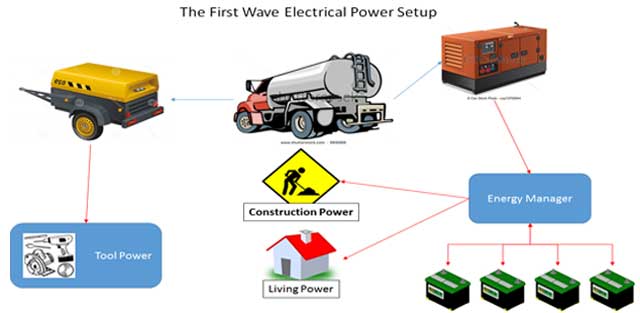
First Wave Power Setup Overview
The core of the Duplicable City Center and Earthbag Village (Pod 1) power systems would look like this:
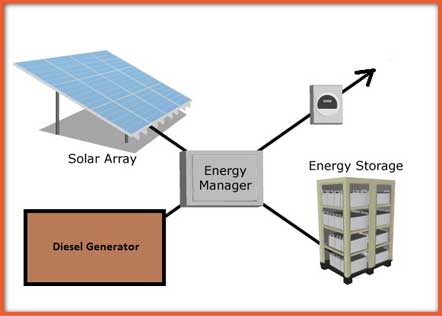
Off-grid Energy Foundations
First we would install the batter bank and power management systems so it can be charged using the generators. We would then begin our transition to solar power by connecting the solar array to the system as quickly as possible to decrease use of the generators.
Note: The battery bank does not need to be full size yet, but must have the capability of increasing to that size in the future.
Based on our energy needs we would also:
- Purchase additional 175 kW diesel generators to connect into the power management system for distribution.
- Add the two 175 kW generators to meet power requirements for the completed Duplicable City Center and Earthbag Village (Pod 1). Fuel acquisition will be calculated by using the same principles for sizing and providing fuel as described above. These 175 kW generators will be mounted or placed on permanent concrete slabs near the Energy Manager, Duplicable City Center, and Earthbag Village (Pod 1).
- Generators would be added piecemeal with the first 175 kW generator coming in midway through (or when load demands it) and the second added upon the activation of the Duplicable City Center radiant floor heating.
- Keep the 100 kW generator non-permanently connected to the system (on the trailer) so it may be moved to provide power to remote construction projects and emergency power where/as needed.
Here are the 175 kW generator power efficiency and production projections for comparison with the chart above. Comparing these projections will help maximize efficiency and minimize fuel use for your generators.
THE SECOND WAVE: POWER FOR 50-100 PEOPLE
 By now, construction of the initial components of One Community are in full swing and we’re ready to bring on additional team members to accelerate the pace of progress. Along with population increases we would see the demand for electrical power and hot water increase. For instance, the Duplicable City Center kitchen and large-scale laundry facility would both be fully operational during this time and draw considerable electric power. As the demand grows, we would increase taking advantage of the energy efficiencies that are associated with larger systems like these and implement additional energy reduction and conservation measures too.
By now, construction of the initial components of One Community are in full swing and we’re ready to bring on additional team members to accelerate the pace of progress. Along with population increases we would see the demand for electrical power and hot water increase. For instance, the Duplicable City Center kitchen and large-scale laundry facility would both be fully operational during this time and draw considerable electric power. As the demand grows, we would increase taking advantage of the energy efficiencies that are associated with larger systems like these and implement additional energy reduction and conservation measures too.
| Equipment Needed for this Phase | Cost | Details |
| 175 kW generator + add-on options | $24,949 | 175 – 350 kW (4200 – 8400 kWh/day possible with both 175 kW generators now up and running and the 100 kW generator as a more mobile backup) |
| 1000 gallon Fuel Bladder | $2,406.69 | 1000 gallon fuel bladder |
| Fuel for 6 months 175 kW Gen or (100 kW generator) | $25,284.10*($29,248.13) | @50% for 4.8 hours per day* (@50% for 8.4 hours / day) |
| Wind Turbine(s)? | ?? | We will have the necessary experience with our location to effectively evaluate this option by this point |
| Flow Battery | Forbes Article About This | ?? | This technology (or other large-scale options) should be ready for market by this time |
| Total | 52,639.79 | This number will meet our needs and the addition of wind turbines, flow batteries, or other options will only be considered if proven financially and sustainably superior to other options |
* This is smaller for the same amount of energy production due to the increased efficiency of these generators when running at a higher percentage of its maximum.
50-100 PEOPLE POWER IMPLEMENTATION DETAILS
As development continues, the hydronic systems become operational and the total load on the Energy Manager will increase. As energy saving measures are added, the load will decrease. Overall, our total demand for power, both hydronic and electrical, would increase. This construction period would be very energy-intensive and would require large amounts of fuel. The Duplicable City Center radiant heating would be the largest consumer of power (both hydronic and electric). Therefore, it would be beneficial to have the core energy system (all solar arrays) and some of the energy-reducing measures in place before the hydronic system is enabled. Further evaluation on the property would dictate whether wind power solutions are viable.
The following are the action steps for this phase of energy infrastructure development:
- Start expanding the solar capabilities of the property.
- Every kWh created by solar arrays reduces the amount of fuel that needs to be purchased and transported to the property
- Experiment should be done to identify best practices for the solar/electrical conversion
- If possible, you may want to research creating biodiesel on the property to reduce your reliance on external fuel sources
- Find a permanent position for the last of the 3 generators. You’ll be foregoing mobility, but you’ll need all the generators connected during this time of significant energy usage
- Make a decision about the wind turbines and large-scale and longer-term energy storage options
Related to the last bullet-point above, here are the viability projections for energy storage starting with small amounts of energy being stored for less than a day and progressing to megawatts being stored for a year or more. The red line is our power demand and what you see is that with storage capacity there is an amount of stored energy that can offset cost in the different mediums: batteries, compressed storage, etc. If we need to store power for 1 month, batteries are not a viable solution, but hydrogen storage would be once energy storage needs are sufficient to warrant the added expense of creating infrastructure like this.

Different Energy Storage Solutions
THE FIRST FIVE YEARS: POWER FOR 100-400 PEOPLE
 Throughout the first five years on the property, One Community is purposed to construct several key structures. These will include the Duplicable City Center, the Earthbag Village (Pod 1), Straw Bale Village (Pod 2), food greenhouses, and additional village models if possible. The expectation from residents working in these areas and visitors touring our community would be that the solutions we are testing and displaying are genuine and practical solutions. During this time the Phase I energy system (described above) would be completely developed and the new focus would be testing and monitoring this system, fine tuning and conservation strategies, and planning and implementation of next steps.
Throughout the first five years on the property, One Community is purposed to construct several key structures. These will include the Duplicable City Center, the Earthbag Village (Pod 1), Straw Bale Village (Pod 2), food greenhouses, and additional village models if possible. The expectation from residents working in these areas and visitors touring our community would be that the solutions we are testing and displaying are genuine and practical solutions. During this time the Phase I energy system (described above) would be completely developed and the new focus would be testing and monitoring this system, fine tuning and conservation strategies, and planning and implementation of next steps.
| Equipment Needed for this Phase | Cost | Details |
| To be determined | TBD | You should choose this development-phase of energy infrastructure based on your goals and budget. |
100-400 PEOPLE POWER IMPLEMENTATION DETAILS
This phase of development would be about monitoring all electrical energy being consumed and making expansion decisions based on needs and what you learn. The monitoring is suggested to be accomplished through meters for all individual living spaces and ammeters on any main power lines that would output the amps being used at that instant. Since the voltage will be known, the power will then be a simple calculation done by either a designed system or one bought off the shelf. That power (in Watts or kW) will then be logged over time to get the amount of energy in kWh used during the course of the day.
The following picture illustrates this with each “A” representing a monitoring point that communicates with a power display feeding data to central data analysis point:
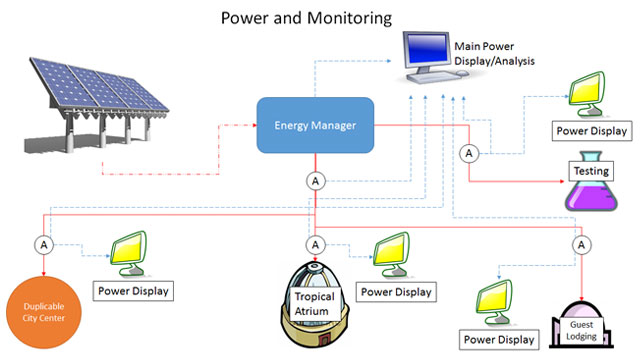
Monitoring Electrical Energy Used by 100-400 People
Electrical Power Monitoring would have displays at the source and connections to a Main Power Display that would monitor and control electrical energy management sub-system.
Similarly, hot water used in showers, domestic use, and hydronic systems can be monitored by knowing the flow rate, temperature, and amount of time used. With instantaneous water heaters at points of service, the electrical energy draw from those units could also be used with the addition of the known hot-tank water temp and the flow rate of the use.
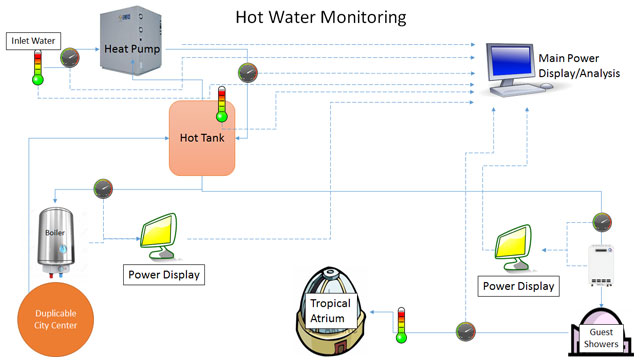
Hot Water Monitoring and Data Analysis
In short, hot water monitoring needs two pieces of data for each point: temperature and flow. For showers and the boiler, temperature can be replaced by an electrical power reading which will already be monitored by the electrical energy monitoring software and relayed to the Main Power Display. For everything else, temperature and flow monitors will do the job.
Specifically monitoring all of these things will allow you to fine tune your consumption patterns (and open source share your results if you want to). We think tracking these metrics for guests would also be a major benefit to the mission of One Community by showing the constant flow of temporary residents/visitors an accurate report of their energy usage while staying. In so doing, we’d help to educate people and give them the opportunity to become more conscientious about their use.
This would also create ultra-accurate energy needs assessments to help us with our planning and construction of each additional open source village needed for expansion to host people beyond the initial 400.
THE LONG TERM: POWER FOR 400+ PEOPLE
Sustainable energy, and renewable energy abundance, is all about careful planning and system redundancy. We realized we won’t be able to effectively plan our power needs beyond the Earthbag Village (Pod 1) and Duplicable City Center until both of these components of our infrastructure are complete and we’d gained the experience of using the systems designed above. While it is predictable that we would actually increase our energy efficiency over time due to increased conservation methods and “fine tuning” of our usage patterns, it is also predictable that we would have energy needs we haven’t accounted for.
Learning from experience, learning more about our specific property and how effective options like wind power may be, possible implementation of new energy technologies, and a better understanding of our specific needs would all be crucial to planning power infrastructure for the Straw Bale Village (Pod 2) and beyond.
RESOURCES
- One Community Facebook Archive of Resources
- Article: “25 U.S. Cities Leading the Sustainability Charge”
- .gov Energy and Cost-savings Calculators for Energy-efficient Products
- Use this page (click here) if you have a resource you’d like to suggest be added here
SUMMARY
 Completely off-grid energy production in remote locations requires planning and a detailed phase-in process if the goal is to build as effectively and efficiently as possible. One Community is open source sharing this page as the design process and rational we came up with before determining that a grid-tied system would be more cost effective and dependable while still meeting our 100% sustainability needs. Visit our Highest Good energy page for the grid-tie rationale and our most current design and implementation details. Visit our Helping Page if you have a project that is remote enough to warrant finishing this 100% off-grid tutorial for yourself and as an open source guide to others.
Completely off-grid energy production in remote locations requires planning and a detailed phase-in process if the goal is to build as effectively and efficiently as possible. One Community is open source sharing this page as the design process and rational we came up with before determining that a grid-tied system would be more cost effective and dependable while still meeting our 100% sustainability needs. Visit our Highest Good energy page for the grid-tie rationale and our most current design and implementation details. Visit our Helping Page if you have a project that is remote enough to warrant finishing this 100% off-grid tutorial for yourself and as an open source guide to others.
FREQUENTLY ANSWERED QUESTIONS
Q: Why aren’t you designing your system to be 100% off-grid?
Q: How are the generators sized?
Generators are sized using the maximum continuous wattage (power) that they can reliably create. If, when every device is turned on and running at maximum, the power draw is 95 kW then we select a 100 kW generator. Most of the time the power draw on the generator will be much less than the maximum load.
Q: How is the system sized?
The energy system will always be designed for the worst-case, maximum load. This would include sizing wires, fuses, and busses to handle every possible device and appliance turned on at once. Even though this is a very unlikely scenario, it ensures that the system will always work within its safe limits.
Q: In what case would the generators activate?
In the beginning we will use the generators for many different activities, but as the project adds sustainable energy sources to the property the generators will be phased-out in favor of the more sustainable options. However, we will keep the generators on site, in running order and fueled in case of a fault in any part of the energy management system. Or to as make-up energy for the system.
Q: What happens in the case of a massive battery fault?
In this scenario the battery banks are damaged or in some way inhibited from providing the stored power back to the energy manager. As the energy manager senses the drop (or stop) of battery power it will send a “Start” command to the backup generators causing them to start, reach working RPM, and sync into the energy manager’s grid. During this time the total load of the project less the total amount being created by sustainable means at that instant would be placed on the generators. They would run until battery storage was back online or the sustainable systems were creating enough power to cover the current load.
Q: What happens when there is not enough power to charge the batteries? (Cloudy Week Scenario)
Sometimes there will be a deficit of energy created in the day (solar, wind…etc.) and the remaining energy needed will have to be “made up.” The energy manager will run one or more generators at the most fuel efficient load for as long as it takes to charge the system. Once charged, the energy manager will automatically shut down the generators. In times of low light due to atmospheric disturbances this could become a daily occurrence to meet the forecasted demands on the system.
An example would be the energy manager calculating the amount of energy in storage and if the stored power does not meet the energy needs of the system for the next 24 hours the generators would run after the solar cycle (evening) to “top off” the batteries for the following day.
Q: What happens in the case of an energy manager malfunction?
In the case that the energy manager fails to operate or detects a fault, the system would go under total generator control. Because improper battery management can cause catastrophic damage, it is safer to allow the generators to take on the entire load of the system and remain in that state until the energy manager fault is discovered and fixed.
Q: How does the system change in an emergency scenario?
As a fault is detected in the system the energy manager, programed in advance, will compensate by utilizing the different power storage and production equipment options that are connected to the system.
Normal management would be the phasing in and out of sustainable power sources as they come online. However, in the event that a subsystem fails in such a way that could be damaging the entire system, like a short circuit or an unexpected voltage spike, the manager will remove the offending device from the system and rely on other sources. Mechanical systems (fuses, breakers) will also be in place in the case of a very sudden change in voltages that could be too quick for the manager to compensate, such as a lightning strike or short.
Q: What are the fail-safe measures?
Whenever possible all parts of the system will be designed to fail in a way that provides the safest possible scenario for the rest of the system. Whenever possible the system will also continue to provide power. This said, there could still be times where a catastrophic failure fail-safe would be to cut power completely. The details of this system of fail-safes would depend on the environment in which the system is placed and it’s particular construction and components, so at this time there are no definitive plans.
Q: What systems would be active in a power emergency?
In a power emergency only essential systems should be left on. The following factors would determine which systems are essential:
- The severity of the power emergency: The more severe the emergency, the more systems that would need to be turned off.
- The season: Heaters, for example, would be non-priority in the middle of summer and crucial in the winter.
- Consideration of how often a specific unit is drawing power: If the system is off most of the time it might not hurt to leave that unit in an off state.
- The power draw: If the the hot tub circuit draws 200 times the power that the lights in the Duplicable City Center does, it would be useful to turn that device off, before the lights go out.
- Importance of systems: As in the hot tub example in #4, systems that closely relate to human basic needs (food, shelter, water, etc.) should be prioritized. To make power conservation easy in an emergency, priority circuits should be marked both physically and in the energy controller.
To help put the energy needs of different systems in different situations into perspective, here is a chart showing how much specific components of One Community will contribute to peak wattage needs:

Emergency Power PEAK Wattage Needs Assessment
Now compare this to this chart that shows how much specific components of One Community will contribute to total energy needs:

Emergency Power TOTAL Wattage Needs Assessment
The point of these two charts is to show that components like the heat pump, dryer, and water heaters draw the most power from the perspective of total daily needs because they will be running consistently. Individual heaters, the boiler/water heaters, dryer, and parabolic heaters are the top contributors to peak wattage (energy spikes) because they draw a lot of power at one time. The general trend is still that those items high on one chart are also high on the other chart, but the details will vary and this can be extremely helpful to understand and consider in emergency power situations. Also, to conserve power, the hot tub (a huge energy consumer) has been designated as an item to be used only when surplus energy is available (like in the summer months).
Q: How much bio-diesel will you need?
The fuel source should be sized to provide enough for the running of the generator to meet team power needs for at least the amount of time the team is planning on this phase multiplied by a safety factor of 1.2. For the Landing Party of 20 people we assume that we will be using roughly 4.2 kWh/day per person (from Pod 1 per capita energy consumption). Over the course of the day we can assume that we run the generator for 5 hours continuously per day meaning that during that 5 hours the generator is running at 16.8 kW or 16.8%. Using the graph in the related section above, we find that the 100 kW generator will consume 3.34 gallons per hour at that load. Multiplying the number of hours by the fuel consumption rate gives us 16.7 gallons/day times our safety factor of 1.2 gives us a final value of 20 gallons per day for the average day.
Fuel storage on site would then be divided by 20 gallons per day to give us the number of days the fuel source can sustain the party. The 100 kW generator with the 250 gallon base tank would last the party roughly 12.5 days without filling. Fuel for an entire month would be 620 gallons total. At today’s prices that would come to roughly $2,480 per month for normal or $2,000 for farm diesel.
Q: What are the benefits of bladder storage for fuel?
Storing fuel in a large bladder is by far the most economical way to store the biodiesel used by the generators. However, bladders are flimsy and easily punctured. They cannot be buried either, so they would have to sit on the ground somewhere protected from heat-sources, and sharp objects.
Q: What are the benefits of tank storage for fuel?
While Tanks are more expensive than bladders, they can be buried to keep them away from heat sources and punctures. Larger tanks would take a large piece of land-moving equipment to place underground.
Q: How long will the batteries take to drain?
Very simply, batteries are rated with their voltage (average) and Amp-Hours. A 50 A-hr 12-volt car battery will provide 1 amp at 12 volts for 50 hours, or 50 amps for 1 hour, or 25 amps for 2 hours, etc. This is the principle used to size the batteries needed on the property. Knowing that we need to provide a certain amount of power (lets say 5 kW) over a certain amount of time (2.5 days = 60 hours) we can start to calculate the batteries needed.
Typical high-voltage batteries can be around 48 volts. Knowing that Volts X Amps = Watts, we can determine the number of amp hours needed:
- 48 volts X (?) amps = 5000 W (5 kW)
- (?) amps = 5000 W / 48 volts = 105 amps (rounded)
Since we need that over the course of 60 hours:
- 105 amps * 60 hours = 6300 amp-hours
If the largest size of battery we can find is 1000 A-H, then we would have to buy 7 of them to cover this draw for 2.5 days.
- 6300 A-H / 1000 A-H = 6.3 â 7
As with all engineering calculations, the largest (predicted) average power drain will be taken into account to build in a buffer to our system.
Q: What sets One Community apart from similar projects?
One Community's open source project-launch blueprinting strategy and the fact that we are open sourcing and addressing ALL elements of society simultaneously are a combination unique to our organization. Together, these will help others duplicate what we do and create self-propagating teacher/demonstration communities, villages, and cities capable of positively impacting every single person on this planet within one generation.
Q: What sets One Community's open source goals apart from similar projects?
To our knowledge, no other project exists that is providing the comprehensive nature and detail of everything we are open source project-launch blueprinting.
Q: What is the specific One Community short-term goal?
- Become a world leader in global-solution information content within 6 months of moving onto the property as detailed in our open source project-launch blueprinting page.
- Expand within 5 years to a community of 200 full-time residents producing ongoing tools, resources, and tutorials while hosting thousands of annual visitors as outlined in our long-term vision page.
- Define the global-solution industry itself as an open source industry, expanding mainstream awareness, appeal, and desire for comprehensive sustainability by demonstrating and sharing a more attractive and fulfilling way of living that people can have if they desire to create it also.
- Teach as many people as possible to duplicate and/or evolve our global transformation model.
Q: What is the ultimate One Community long-term goal?
To transform our world into a sustainable and happier one through teacher/demonstration communities, villages, and cities to be built all over the world. We will work with these hubs as our open source partners and fellow leaders of the open source, Highest Good of All, and sustainable planet movement leading to a New Golden Age of cooperation, collaboration, innovation, creativity, sustainable living, and increased happiness for the entire human organism.
Q: How are you funding One Community?
We are still seeking funding. Please see our Funding Related Details Page.
Q: Where will One Community be located and why?
Click HERE for property details that include why we have chosen the location we have.
Q: How far is One Community in the creation process?
Visit our progress page for a regularly updated list of our accomplishments and progress. Visit our blog for our on-going mini-updates and weekly summaries of accomplishments and progress.
Q: Why not just build a small-scale prototype home or community that includes a minimum-scale revenue-generating demonstration/operation? Wouldn't this get things going faster?
This small-scale operation already exists as Airbnb. What we see as missing is a complete model for self-sufficiency that is open source and reasonably replicable. Even complete models for self-sufficiency already exist in the form of the many eco-villages out there. What none of those offer though is any sort of understanding and/or path for how average people can replicate them. We also think there isn't enough of a compelling reason for most people to bother with changing how they live now to engage such a path/project, so our project is purposed to provide and demonstrate that too.
From a total global-change perspective though, we think it is even more important to create a permanent example:
- Dedicated to open source
- Capable of providing for the complete needs of hundreds of people.
- Providing the support needed so residents can work together on open source creation full-time.
- Revenue generation and space for expansion to grow to over a 1000+ full-time resident-volunteers.
- Able to support the establishment of other open source teacher/demonstration/R&D hubs around the world.
This is why the intended property, village models, social architecture and economic focuses are all big. To support faster and broader implementation, we are also developing everything so it is modular and implementable as individual components. This will allow for anyone who doesn't desire the full teacher/demonstration hub approach to have options too, but our primary goal is to demonstrate the complete teacher/demonstration hub as easy enough, affordable enough, and attractive enough for average people with average means to want to replicate it and/or use what we provide to build their own version.
Q: If you are giving everything away through open source, how do you intend to make money?
Our model is designed to prosper specifically because we are giving everything away through open source project-launch blueprinting. We accomplish this through eco-tourism marketed with the open source infrastructure we have already created and other supported revenue streams outlined on our revenue streams page. All of this further promotes our model of spreading sustainability and actively promoting and distributing even more open source blueprints for duplication by as many people as possible.
Q: How will this help people in Third World countries and other areas that need resources most?
Using the four-phase strategy above, we wish to demonstrate building a teacher/demonstration community, village, and/or city as profitable for large investors and/or a way for small groups of people to pool what resources they have and get out of debt. We see this spreading and bringing resources to the areas that need them most because building these villages in these areas will be more affordable and easier to do with less building restrictions.
Q: How do you stop the model from being totally capitalized without the positive intent of the original model?
We are not focused on putting limitations on the use of everything we are creating because of our open source commitment. We will, however, directly support any organization contributing specifically to open source project-launch blueprinting and operating for The Highest Good of All.
Q: Where would I find a more detailed description of how this works?
Please visit our About Us page, Methodology page, and Site Map for more comprehensive descriptions and links to complete details for every aspect of One Community.
Q: What about safety?
We consider a community of 500 people with shared goals and vision more safe than current living models. We think even a group of 50 people working together can handle any reasonable challenge.
 One Community
One Community




